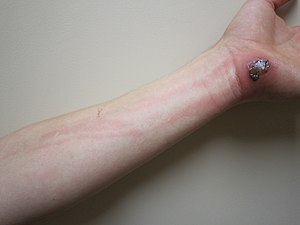- Home
- Editorial
- News
- Practice Guidelines
- Anesthesiology Guidelines
- Cancer Guidelines
- Cardiac Sciences Guidelines
- Critical Care Guidelines
- Dentistry Guidelines
- Dermatology Guidelines
- Diabetes and Endo Guidelines
- Diagnostics Guidelines
- ENT Guidelines
- Featured Practice Guidelines
- Gastroenterology Guidelines
- Geriatrics Guidelines
- Medicine Guidelines
- Nephrology Guidelines
- Neurosciences Guidelines
- Obs and Gynae Guidelines
- Ophthalmology Guidelines
- Orthopaedics Guidelines
- Paediatrics Guidelines
- Psychiatry Guidelines
- Pulmonology Guidelines
- Radiology Guidelines
- Surgery Guidelines
- Urology Guidelines
A case of Ascending upper limb lymphangitis

A case of Ascending upper limb lymphangitis reported by Dr.Leopold Simma Dr. Michael Joseph Barrett and published in BMJ Journal of Case Reports.
A 7-year-old boy presented with ascending erythema of his left hand with erythematous extension to his axilla. At present, the boy was afebrile, well-appearing and complained of itching and swelling of the hand, which started the evening prior.
On examination, there was two insect bite marks on the index finger with erythematous, non-tender swelling inclusive of the index, middle fingers and dorsum of the hand with an extension via a superficial fine erythematous line from the wrist to the axilla via the cubital fossa figures 1 and 2).
A clinical diagnosis of lymphangitis was made. Treatment was commenced with flucloxacillin and immobilization. Twenty-four hours later, the erythema had faded substantially.
Lymphangitis is inflammation of the lymphatic channels that occur as a result of infection at a site distal to the channel and may spread within hours. Group A beta-hemolytic streptococci are the most common causes of bacterial lymphangitis and, in severe cases, can lead to bacteremia, sepsis, and death. He had no complication or recurrence.
The carry home points from the case are -
Minor lesions can result in impressive cutaneous findings.
Do not forget to immobilize the affected limb.
For more details click on the link :
http://casereports.bmj.com/content/2017/bcr-2017-221602.full

Disclaimer: This site is primarily intended for healthcare professionals. Any content/information on this website does not replace the advice of medical and/or health professionals and should not be construed as medical/diagnostic advice/endorsement or prescription. Use of this site is subject to our terms of use, privacy policy, advertisement policy. © 2020 Minerva Medical Treatment Pvt Ltd